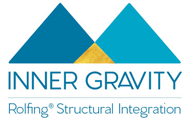What is ROLFING® structural integration?
“One individual may experience his losing fight with gravity as a sharp pain in the back, another as the unflattering contour of his body, another as constant fatigue, and yet another as an unrelenting threatening environment. Those over forty may call it old age; yet all these signals may be pointing to a single problem so prominent in their own structures and the structures of others that it has been ignored: they are off-balance; they are all at war with gravity.” – Dr. Ida P. Rolf
Rolfing® helps the body be better aligned in gravity. It does not focus on one precise area of pain but rather sees the body as a whole. Even while working locally, the Rolfer™ thinks globally.
Rolfing® manipulates the soft or connective tissue in your body. Connective tissue or fascia is a complex network present throughout your body, from the bone level to the skin. Through pressure and strokes we free the tissue from adhesions and tensions that have appeared throughout the years in order for your body to regain length, elasticity, alignment and balance.
Rolfing® is usually practiced in a series of 10 sessions. During those 10 sessions we work together on the entire body.
Sessions 1 through 3 are referred to as the sleeve sessions. They teach your body how to respond to Rolfing, start unwrapping the layers of tension, and help find breath and support.
Sessions 4 through 7 are referred to as the core sessions. They focus on the mid-line and structures close to the spine to give you more postural lift and length.
Sessions 8 through 10 are the integration sessions, focusing on the function of the body as a whole; helping you use the newly found ease of movement and enjoy the increased sense of well-being.
Dr. Oz on The Oprah Winfrey Show talking about Rolfing® (2007)
Robyn Martin’s does a great job describing Rolfing® in this lecture.
What 2 Hours of Rolfing® Did To My Body (Andrew Perlot)
Rolfing Children
Imagine the body as a stack of segmented blocks: head, shoulders, thorax, pelvis, and legs. When these blocks are aligned correctly, a straight line can be drawn, beginning from the top of the head, which will touch the ear, shoulder, pelvis, leg, and ankle. In this optimal vertical alignment, gravity will work to support the body. This is because the weight of each “block“ is close to a common, central (vertical) axis. Hence, each block “rests” on the one below it. In such a “resting” state, our bodies use far less energy to move.
In a body that is out of alignment, however each of the “blocks” does not rest on the one below it. For example, when a person habitually hangs his head, the force of gravity reinforces this downward trend. If it weren’t for the muscles in the back of the neck that initially compensate for this condition, that person would always look as if he were about to fall over.”- Robert Toporek
Children benefit from Rolfing just as much as we do, if not more. The first trauma in life is birth. Then baby starts to bear weight on her legs and arms, lift her head…. As soon as we’re born we start creating tensions in our bodies. And for millions of reasons some babies just don’t develop quite normally. The sooner you can help a child stack her own blocks, the better.
Robert Toporek is an advanced Rolfer™ who has worked extensively with kids and produced this great videos back in the 80’s: The promise of rolfing children.
It is about 30 minute long but if you want quick visual examples go to Asher (at 11:30 min) or Nicole (20:00min).
Parents report physical improvements as well as behavioral and emotional improvements in most of the children. Ida Rolf used to say something to the effect of : “I work on bodies because that’s what I can put my hands on”, but knowing fully that her impact was much deeper.
I offer a limited number of FREE 30 minute sessions for children (0 to 12) because I believe in the importance of body work for children.
I also do paying sessions for children of all ages of course. But if you know an older child who needs Rolfing but who can’t really afford it, let’s talk about it.

